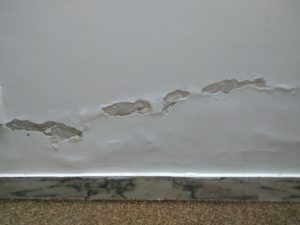
Here chartered surveyors Anderson Associates look at the three different types of damp, how you can identify them and put them right, and why you should always consult us if the home you are about to buy has a damp problem.
Penetrating Damp
This occurs when moisture gets into the property via ceilings, walls and floors. If the home has poor-quality plumbing and pipework, a leaky roof or guttering, missing roof tiles or poorly-fitting doors and windows, then you are more likely to be affected by penetrating damp – which is also known as lateral damp.
Tell-tale signs to look out for include damaged or misshapen plaster, rotting skirting boards and floor timber, and damp patches on the walls. If condensation occurs on existing cold surfaces, then the damp could quickly grow into mould.
One advantage of this type of issue is that, once the source of the moisture has been identified, it should be relatively straightforward to put right.
Rising Damp
This is caused by moisture being absorbed into a property’s structure from the ground upwards.
It is almost always due to an external source, such as high ground levels bridging the damp proof course (DPC), external render/detail covering the DPC and extending to the ground, a leaking gulley or a below-ground drain.
Rising damp manifests itself through a tide-mark on the wall, usually a metre or less from the ground. This means the plasterwork, paint and wallpaper may crack or peel. If it spreads, then the skirting boards and flooring can also show signs of decay. There will often be a musty smell in the affected room.
Remedial works normally involve reducing external ground levels, improving external wall details and repairing damaged rain and waste-water pipes.
It is considered that chemically injected DPCs do not necessarily provide an effective moisture/damp barrier, as the procedure invariably treats just the symptoms and does not address the underlying causes.
Internal replastering in rarely required, as if the source of damp is removed, the walls will eventually dry out to acceptable levels, although this could take up to 12-18 months.
In older properties where no DPC is present, full damp removal is rarely achievable. However, by undertaking the works advised in Anderson Associates surveys, damp can often be reduced to a level where it does not present a major issue.
Condensation Damp
This is a much more common form of the problem. It is caused by water vapour within the property which is unable to escape and usually forms a mould with blurred, soft edges. It tends to get worse in cold weather, unlike penetrating damp, which is more of an issue when it’s been raining heavily.
The presence of condensation damp usually indicates there is an underlying problem, for instance with ventilation or air conditioning. Frequently turning central heating on and off can exacerbate condensation issues.
It is a relatively straightforward problem to fix. Remember to keep rooms well ventilated, even if it’s just by leaving the windows open whenever possible. In the case of kitchens and bathrooms, consider fitting extractor fans or dehumidifiers to reduce the level of moisture.
Anderson Associates – Independent Chartered Surveyors in Martlesham
If you are looking to buy a property and see what you think could be damp, then you should be consulting independent chartered surveyors, such as Anderson Associates. We cover Suffolk, Essex, Kent, East and South East London.
We will work to identify the type of damp problem the building is suffering from. We work for you and not the mortgage lender, and we will always be looking for the cause of the damp, and not just the symptoms. Some damp-proof courses and timber treatments which lenders can insist on either aren’t necessary or won’t get to the root of the property’s problem.
If you opt for one of our full building surveys, we will be able to give you an idea of how much it will cost to put the problem right. In the case of older, historic or listed properties, we will also be able to advise you if any of the work requires local authority consent. To get in touch, follow this link.
(Photo: WIKIMEDIA COMMONS)